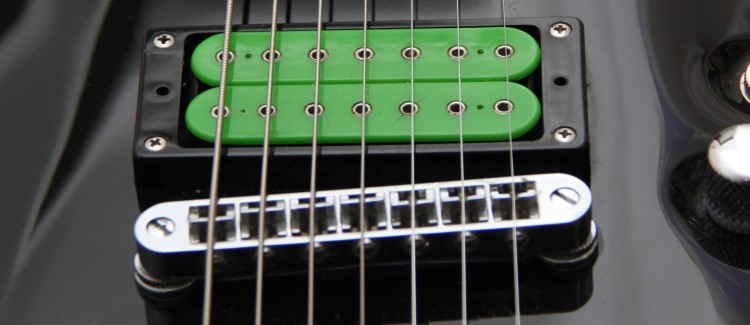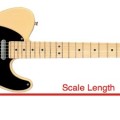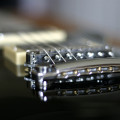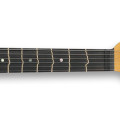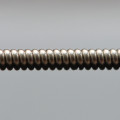My very first guitar was an Ibanez V30 acoustic that I inherited after my grandfather died. But the first guitar I bought myself was a Cort M520, about five years ago. Still the one I use most, actually. When I was going to buy it I did a lot of research. I Googled (I’m good at that!), asked around on forums and asked knowledgeable friends. Still, I felt I really wasn’t in control. It all turned out great, but here are some tips I’d like to share I wish I’d known five years ago (focusing on electrics):
1. Decide what pickups you want
There are two types of pickups on an electric guitar: single coils and humbuckers. Humbuckers have a “fatter” sound and are commonly used for heavy metal and jazz. They have two coils that together cancel out noise, and are commonly wider that single coils. Most Les Pauls have humbuckers. Single coils have a “crisper” sound and are commonly used for classic rock and anything with less distortion. They are commonly narrower than humbuckers. Most Stratocasters have single coils. Try out the difference and try to find out what kind of pickups your favorite guitarists are using. Don’t be fooled by appearance though, the Iron Maiden guitarists for instance play Stratocasters but have replaced the original single coils pickups with humbuckers specifically made narrower to fit into a Stratocaster.
It’s easy to switch pickups in a guitar if you’re not happy with the sound, but it’s more difficult to switch between the types. You can also get a guitar with a mix of pickups – a fat strat (like my Officecaster) with humbucker in bridge position and single coils in middle and neck, or like my Ibanez S470 with humbuckers in bridge and neck and single coil in middle. Pickup configuration is written from bridge to neck with H being humbucker and S single coil. So a Les Paul is an H-H, a strat is S-S-S, a fat strat is H-S-S, my Ibanez is H-S-H and a Telecaster is S-S.
2. Decide what kind of neck you want
There are two main things to decide about the neck: its thickness and its length. Thickness and cross-section is the easy part, you just have to find what you like. Some like thin necks like the wizards on Ibanezes, some like thick necks like on vintage Les Pauls.
Length is more difficult, because what we’re really talking about is scale length, the entire length of the string from nut to brigde. A guitar with larger scale length is easier to tune down, if you want to play modern metal. The longer scale doesn’t require quite as thick string gauges before the lower downtuned strings turn to spaghetti. On the other hand, if your fingers are shorter, a shorter scale guitar is easier to play since stretches are shorter.
Most Gibson guitars have 24.75″ scale, most Fenders and Ibanezes have 25.5″. Personally, with not very long fingers, I find 24.75″ much more comfortable, like on my Cort. Scale length will actually matter less in the beginning – you probably won’t tune down at first, and every stretch will be difficult no matter the scale length. But as you progress it will make more difference.
3. Buy it in a store
A lot of people will disagree with me on this, especially on forums, stating that you will always get better value for your money. I totally agree on that, but that requires actually knowing what you’re doing. I had no idea when I bought my first guitar. With the sheer amount of fake copies around, I’d advice no beginner to buy a used guitar. Unless you can spot a twisted neck, worn out tuners or faulty pickups you will be better of buying your first guitar at a physical store where you will likely get it set up for free as well. If you have savvy friends though, that’s a whole other situation.
4. Find your optimal budget
It is important that you don’t spend too little on your first guitar. A cheap guitar will be harder to play, more likely to go out of tune, have fret buzz or other problems that will just put you off learning. On the other hand, expecting to find your dream guitar and spending a lot on it on your first try is ver unrealistic. So what’s a good budget? Very hard to say, but I’d say don’t go below €250 ($300).
5. Try it properly before you buy
If you take my advice from above and buy your first guitar from a store, you should properly try out many guitars before deciding. A guitar store can be an intimidating place, but just ask to borrow some headphones and have the the staff help hook you up to a silent rig. With headphones all of the self-consciousness goes away and you can try guitars without so much self-censoring. Make sure the one you choose feels good, and looks good – you’ll be less motivated to practice on a guitar that doesn’t look like you want (seriously). When you’ve decided on a guitar also try it out when not plugged in, it should ring out clear acoustically even though it’s a solid-body electric.
Do not forget to read reviews! A lot of sites have great review sections, with contributions from both professional editors and the public.
Extra credit
This is stuff that isn’t critical for a beginner, but if you have the time or friends to ask you might be able to prepare for your purchase even more:
- Fret size: lower vintage frets or the modern jumbo frets?
- Tremolo (for cool dive bombs) or fixed bridge (that stays better in tune and is easier to restring)
- Kind of wood in body, neck and fret board
- Lockable tuners and other special details?
Good luck
I hope these tips got you at least a bit along the way. All these tips can make it seem daunting to buy a guitar, but don’t be intimidated. Just do the best research you can and I promise you can’t go completely wrong. Your first guitar is your first step towards finding your perfect guitar, a long and costly journey that will never be complete ;-).

